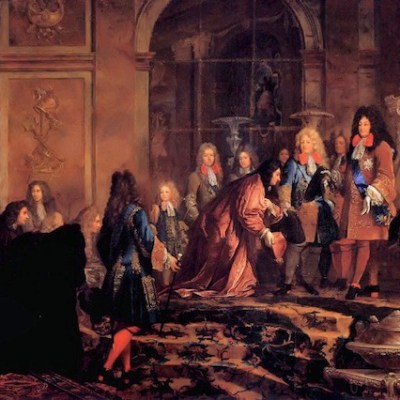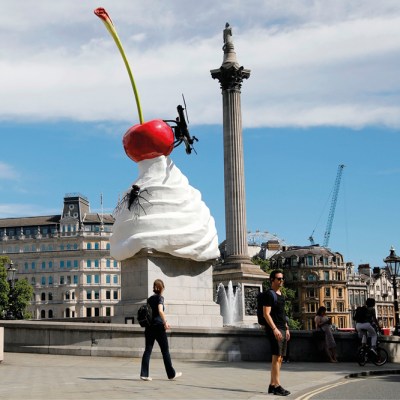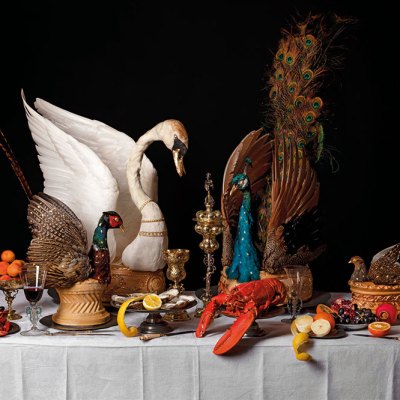This documentary tells the story behind the launch party, back in 2018, for the Metropolitan Museum of Art’s exhibition ‘Visitors to Versailles 1682–1789’. The Bourbons, who knew a thing or two about expressing power through display, would doubtless tip their tricorns to the Met for whipping up such a soirée in their honour. In the film, five of the world’s most innovative pastry chefs, chocolatiers and pudding provocateurs are assembled to conceive and execute creations inspired by the French court. The man charged with choosing (then chivvying) them, like a modern-day Charles Le Brun overseeing his petite académie of gilders and painters, is an institution of another sort: the Israeli-born chef and vegetable whisperer Yotam Ottolenghi.
Although schooled in pastry, here our man limits himself to the role of impresario. In his twenties, he’d been planning to become an academic, and wrote a thesis on the ontological status of the photographic image. So while Ottolenghi has a sophisticated grasp of aesthetic philosophy, all he really knows about Versailles at the outset is that ‘Marie Antoinette never said: let them eat cake’. The film enriches our knowledge of the palace via the restaurateur’s own process of historic immersion, as he pores over cookery books such as Barbara Ketcham Wheaton’s Savoring the Past and quizzes the curator Daniëlle Kisluk-Grosheide and cultural historian Deborah Krohn. Compared to today’s cocooned royals, the French court was astonishingly open. Anyone ‘in civilised dress’ could gain entry to the palace grounds. Akin to a celebrity living in the glare of social media, Louis XIV had little privacy – the daily levee, for example, saw his closest nobles helping him dress. Everyone from Siamese princes and Ottoman ambassadors to Benjamin Franklin was put up in the palace’s neoclassical bedchambers. Thanks to the Académie des sciences, founded in 1666, Versailles deployed the latest technology, in everything from botany to hydraulic engineering. Cuisine was no different. Due to improved refinement of sugar, Ottolenghi learns, ‘they had meringues, delicate pastries, cakes; they had almonds and fruits; they were using orange blossom and rosewater. Technically they could make choux and brioche’. But rather than opt for historic re-creation, the chef decides to seek out pioneers, those pushing desserts into new dimensions.
Still from Ottolenghi and the Cakes of Versailles (2020; dir. Laura Gabbert). Courtesy IFC Films

‘Every good recipe needs to tell a story’ is one of Ottolenghi’s tenets. With that in mind, and after much trawling through Instagram, he selects his five-strong team, including Dominique Ansel, who invented the Cronut; Janice Wong, a Singaporean chocolatier and edible-art entrepreneur; and Ghaya Oliveira, a Tunisian dessert chef and winner of a coveted James Beard award. Dinara Kasko, a young Ukrainian ex-architect who makes geometrically complex cakes using computer-designed moulds, pushes at the edge of the possible, as do British jelly-makers extraordinaire Bompas & Parr. Just as staff undertook herculean labours to mount entertainments at Versailles, from firework displays to equestrian ballets, so it is for this event’s participants. In tropes familiar to devotees of Grand Designs or Masterchef, we witness electricians striving to boost the current to power ‘a whirlpool of booze’, the struggles to fit a giant swan through service doors and a mousse that fails to set at the eleventh hour.
The film’s director, Laura Gabbert, flirts with finding links between Versailles and Fifth Avenue’s colossus of culture. Early on, its general manager alludes to the Met’s vast square footage, annual visitor traffic and number of objects; and notes that some 2,000 people – ‘we have basically every profession that exists’ – are employed there. Let’s not forget, either, that the collection was founded on the munificence of Gilded Age robber barons such as J.P. Morgan – figures who inherited the tastes of European monarchs as well as their sense of noblesse oblige. Controversies do bubble to the surface. Though the Met is considerably less full of colonial loot than many of its counterparts across the Atlantic, its director Max Hollein admitted during the recent furore about monuments and race that the museum’s development is ‘connected with a logic of what is defined as white supremacy’. Moreover, in 2018, having recently received an endowment of $80m, the board decided to make non-New Yorkers pay a $25 entry fee (locals pay a suggested donation) – a decision that was widely criticised.
Still from Ottolenghi and the Cakes of Versailles (2020; dir. Laura Gabbert). Courtesy IFC Films

With the climax approaching, the Met’s army of helpers begins laying out gateaux modelled on plaster reliefs, chocolate Apollo masks and Le Nôtre’s clipped vegetation suggested by cocoa and sweet gum. In the Petrie Court, where millionaire donors will soon be oohing and aahing over these consumable fripperies, is Carpeaux’s marble of Ugolino, the imprisoned Pisan depicted starving to death with his children. And that’s not the only irony. Ottolenghi makes the point that it’s impossible to research the antics of the French aristocracy without envisaging its abrupt terminus: the riots for bread, the tumbrils, the guillotine. They’re like dinosaurs heedless of the onrushing asteroid. And that’s precisely what, in the hindsight of autumn 2020, this viewer felt taking in the jostling crowd, chomping and chattering away in jolly proximity: none of you has any idea what’s just round the corner – a pandemic that will scar the museum world, and may yet deal it a fatal blow.
Ottolenghi and the Cakes of Versailles (2020), dir. Laura Gabbert, is available to rent in the US.
From the November 2020 issue of Apollo. Preview and subscribe here.



